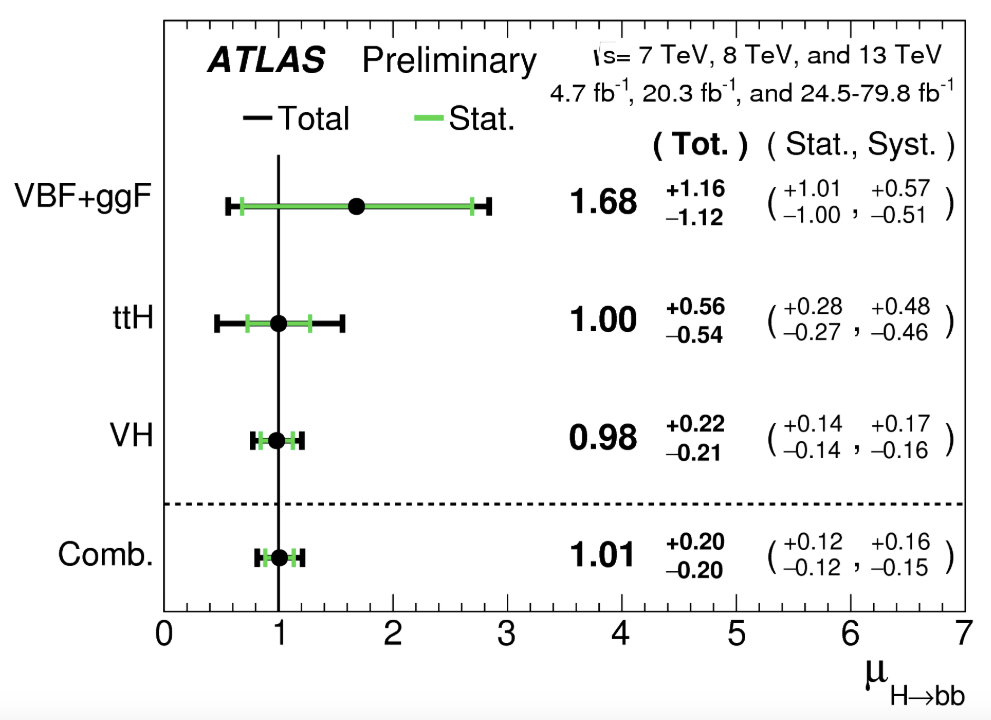Dominant Decay Channel of Higgs Particle Observed at ATLAS
The Higgs boson to the bottom quark decay process (H→bb), the most important decay channel of the Higgs particle was recently observed by the ATLAS experiment at the Large Hadron Collider (LHC). The observation result was first released at the International Conference of High Energy Physics on July 9th in Seoul, Korea.
The ATLAS group from the Institute of High Energy Physics (IHEP) made a major contribution to this new result. This observation confirmed the essential property of Higgs boson of the Standard Model (SM) as the particle that provided mass to all fermions.
The H→bb process is the dominant decay mode of the Higgs boson, which is expected to account for almost 60% of all possible decays, however due to the huge background contribution of the gluon splitting process (g→bb) at the LHC, the H→bb analysis is extremely challenging, and the H→bb decay channel had not previously been observed by any experiment.
In the new results, the ATLAS experiment reported the observation of H→bb decay channel with 5.4 sigma observed significance (ATLAS-CONF-2018-036). As shown in Figure 1, this result was obtained from the combination of multiple physics processes, including the gluon fusion (ggF), Vector Boson Fusion (VBF), W/Z boson associate production (W/Z+H), and top quark associate production (ttH). The Chinese ATLAS institutes and universities made key contributions to the H→bb analysis.
Prof. Liang Zhijun led the IHEP ATLAS team on the analysis of the ggF+VBF process, as shown in Figures 2, and served as analysis leader within the ATLAS collaboration. The IHEP team, composed of Liang Zhijun, Shi Lianshan, Liu Bo and Lou Xinchou, made major contributions in the signal triggering design, background fitting and signal extraction. The group also delivered important oral presentations during the analysis review process within ATLAS.
The wider IHEP ATLAS team, among other things, has also made a key contribution to the operation of ATLAS pixel detector, which is essential to identify b quarks for this analysis.
Prof. Liang Zhijun received his Ph.D. from the Physics Department of Sun Yat-sen University in 2011. From 2011 to 2015, he worked as a postdoctoral researcher at Oxford University and the University of California, Santa Cruz. His major research topic is the data analysis of the ATLAS experiment and the research and development of the next generation silicon track detector. During 2012-2013, he served as ATLAS electroweak physics group co-convener, and contributed significantly to ATLAS electroweak physics. In 2016, he became Associate Professor at IHEP, and worked on ATLAS experiment research and the next generation of Electron Positron Collider.

Figure 1: The new result by ATLAS experiment is obtained from the combination of multiple H→bb analyses, including the gluon fusion process (ggF), Vector boson fusion process (VBF), W/Z boson pair generation process (W/Z+H), top quark companion generation process (ttH). IHEP ATLAS group made a leading contribution to ggF+VBF analysis(ATLAS-CONF-2018-036). (Image by ATLAS Collaboration)

Figure 2:Distribution of invariant mass of b jet pair (mbb)in VBF and ggF process in the analysis led by IHEP ATLAS group (CERN-EP-2018-140). The H→bb signal contribution is indicated by red histogram and red dash line. (Image by ATLAS Collaboration)
For more information please see:
[1].ATLAS press release:
http://atlas.cern/updates/physics-briefing/higgs-observed-decaying-b-quarks
[2].ATLAS conference note about this observation (ATLAS-CONF-2018-036):
https://atlas.web.cern.ch/Atlas/GROUPS/PHYSICS/CONFNOTES/ATLAS-CONF-2018-036/
[3]ATLAS paper on the VBF+ggF H→bb analysis (CERN-EP-2018-140):
https://atlas.web.cern.ch/Atlas/GROUPS/PHYSICS/PAPERS/HIGG-2016-30/
Contact Information
Mr. Guo Lijun
ljguo@ihep.ac.cn